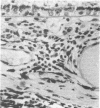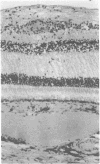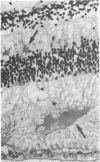Abstract
Ocular pathology in the first European case of human bat-borne rabies is described. The patient was a 30-year-old bat scientist who seven weeks after bat bite developed neurological symptoms and died 23 days later. Rabies virus antigens were detected in brain smears. After extensive virological studies the virus turned out to be a rabies-related virus, closely resembling the Duvenhage virus isolated from bats in South Africa in 1980. By light microscopy focal chronic inflammatory infiltration of the ciliary body and of the choroid was found. PAS-positive exudate was seen in the subretinal and in the outer plexiform layers of the retina, and retinal veins showed endothelial damage and perivascular inflammation. Many of the retinal ganglion cells were destroyed. The presence of rabies-related viral antigen in the retinal ganglion cells was shown by positive cytoplasmic immunofluorescence, though electron microscopy failed to identify definite viral structures in the retina. By immunohistochemistry glial fibrillary acidic protein was observed in the Müller's cells, which are normally negative for this antigen but express it as a reactive change when the retina is damaged. Synaptophysin, a constituent of presynaptic vesicles of normal retinal neurons, was not detected in the retina.
Full text
PDF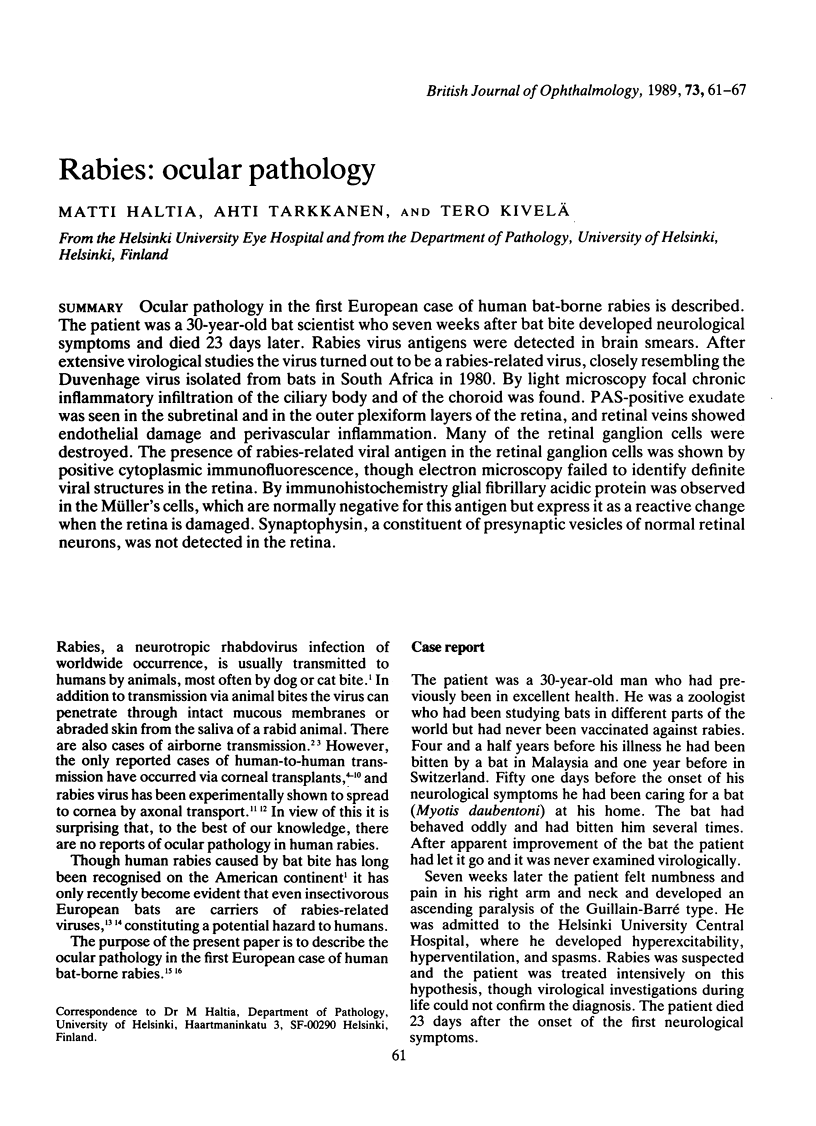

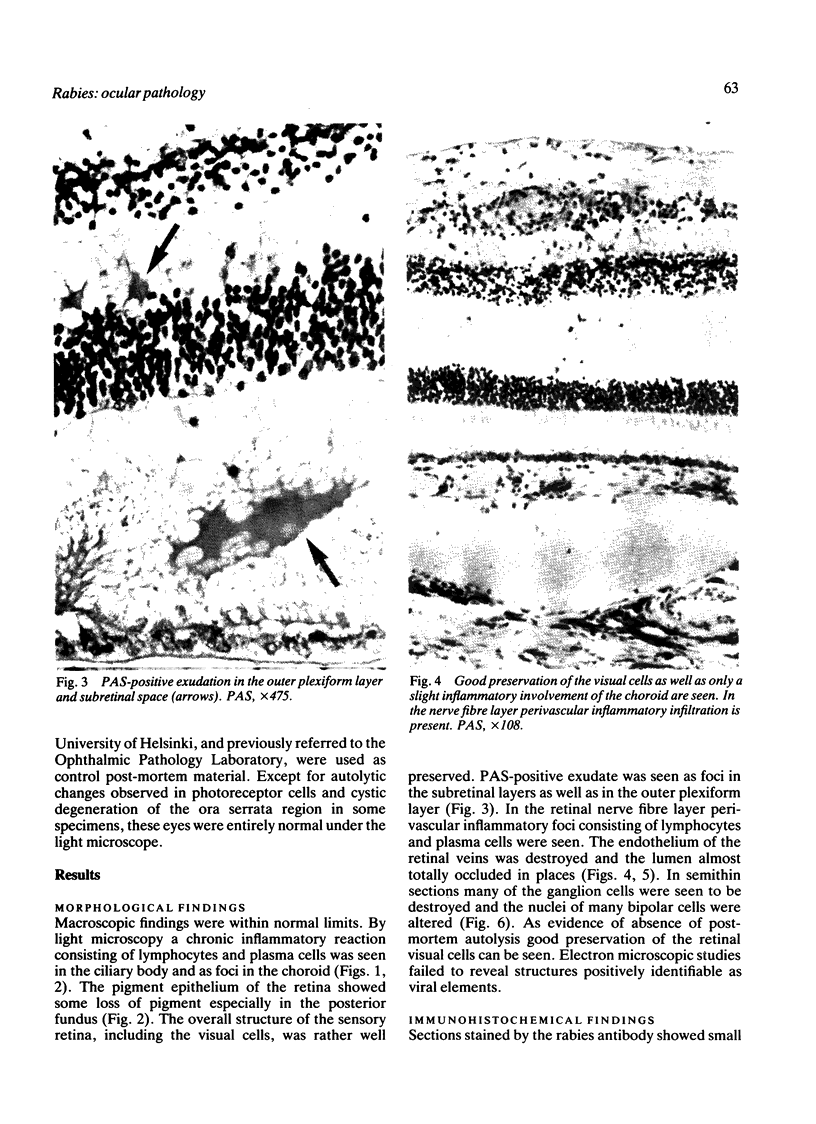

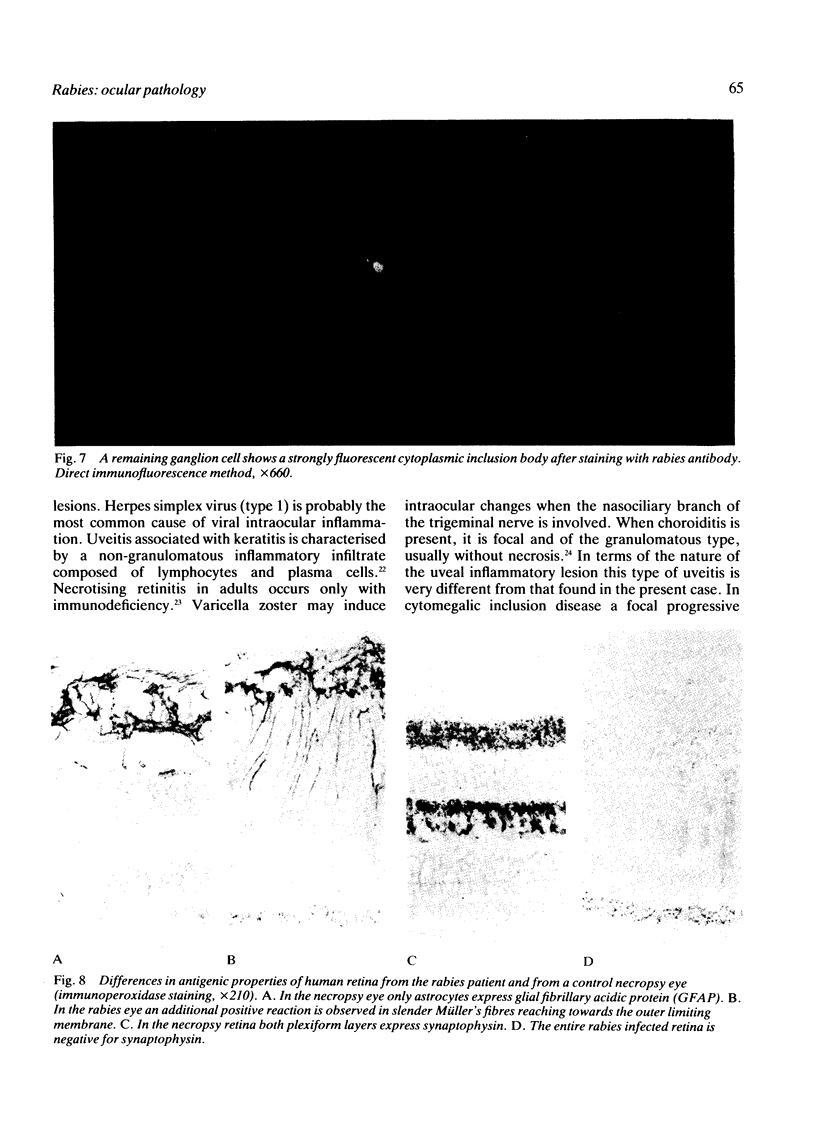

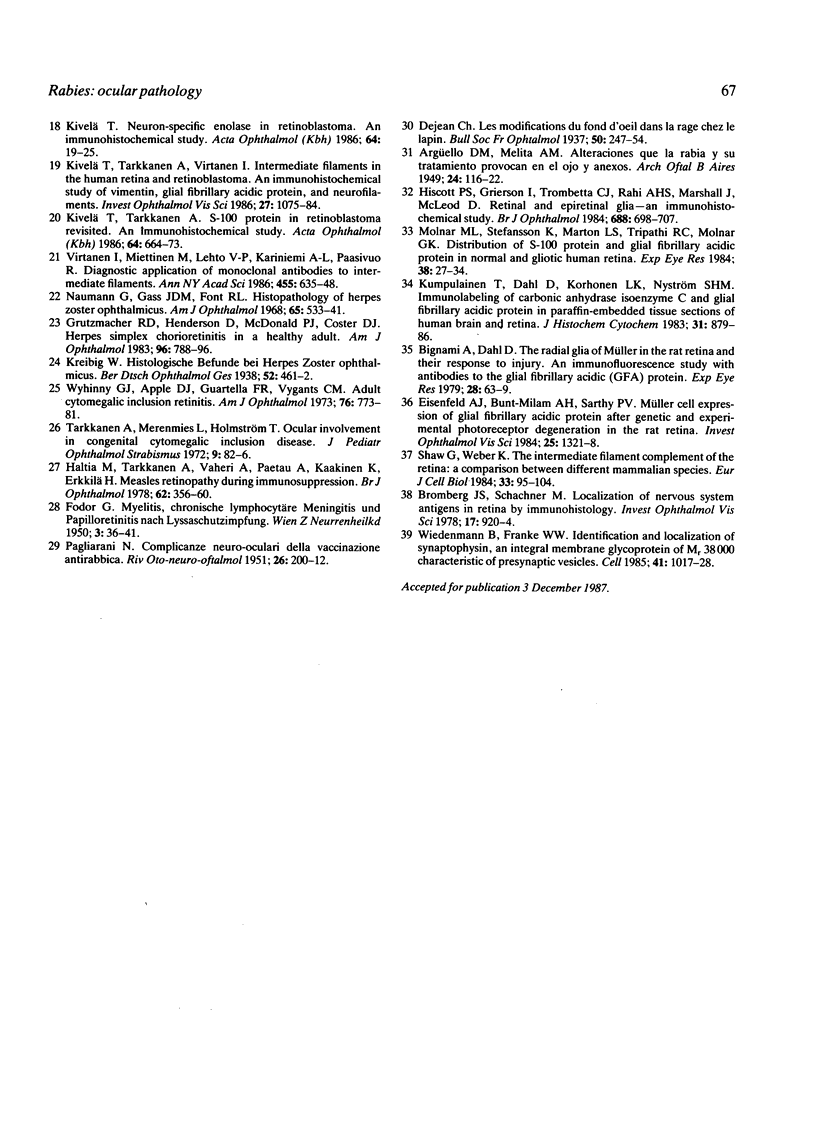
Images in this article
Selected References
These references are in PubMed. This may not be the complete list of references from this article.
- Anderson L. J., Williams L. P., Jr, Layde J. B., Dixon F. R., Winkler W. G. Nosocomial rabies: investigation of contacts of human rabies cases associated with a corneal transplant. Am J Public Health. 1984 Apr;74(4):370–372. doi: 10.2105/ajph.74.4.370. [DOI] [PMC free article] [PubMed] [Google Scholar]
- Baer G. M., Shaddock J. H., Houff S. A., Harrison A. K., Gardner J. J. Human rabies transmitted by corneal transplant. Arch Neurol. 1982 Feb;39(2):103–107. doi: 10.1001/archneur.1982.00510140037010. [DOI] [PubMed] [Google Scholar]
- Bignami A., Dahl D. The radial glia of Müller in the rat retina and their response to injury. An immunofluorescence study with antibodies to the glial fibrillary acidic (GFA) protein. Exp Eye Res. 1979 Jan;28(1):63–69. doi: 10.1016/0014-4835(79)90106-4. [DOI] [PubMed] [Google Scholar]
- Bromberg J. S., Schachner M. Localization of nervous system antigens in retina by immunohistology. Invest Ophthalmol Vis Sci. 1978 Sep;17(9):920–924. [PubMed] [Google Scholar]
- CONSTANTINE D. G. Rabies transmission by nonbite route. Public Health Rep. 1962 Apr;77:287–289. [PMC free article] [PubMed] [Google Scholar]
- Centers for Disease Control (CDC) Bat rabies--Europe. MMWR Morb Mortal Wkly Rep. 1986 Jul 4;35(26):430–432. [PubMed] [Google Scholar]
- Debbie J. G. Rabies. Prog Med Virol. 1974;18(0):241–256. [PubMed] [Google Scholar]
- Duenas A., Belsey M. A., Escobar J., Medina P., Sanmartin D. Isolation of rabies virus outside the human central nervous system. J Infect Dis. 1973 Jun;127(6):702–704. doi: 10.1093/infdis/127.6.702. [DOI] [PubMed] [Google Scholar]
- Eisenfeld A. J., Bunt-Milam A. H., Sarthy P. V. Müller cell expression of glial fibrillary acidic protein after genetic and experimental photoreceptor degeneration in the rat retina. Invest Ophthalmol Vis Sci. 1984 Nov;25(11):1321–1328. [PubMed] [Google Scholar]
- Grauballe P. C., Baagøe H. J., Fekadu M., Westergaard J. M., Zoffmann H. Bat rabies in Denmark. Lancet. 1987 Feb 14;1(8529):379–380. doi: 10.1016/s0140-6736(87)91746-6. [DOI] [PubMed] [Google Scholar]
- Grutzmacher R. D., Henderson D., McDonald P. J., Coster D. J. Herpes simplex chorioretinitis in a healthy adult. Am J Ophthalmol. 1983 Dec;96(6):788–796. doi: 10.1016/s0002-9394(14)71925-7. [DOI] [PubMed] [Google Scholar]
- Haltia M., Tarkkanen A., Vaheri A., Paetau A., Kaakinen K., Erkkilä H. Measles retinopathy during immunosuppression. Br J Ophthalmol. 1978 Jun;62(6):356–360. doi: 10.1136/bjo.62.6.356. [DOI] [PMC free article] [PubMed] [Google Scholar]
- Hiscott P. S., Grierson I., Trombetta C. J., Rahi A. H., Marshall J., McLeod D. Retinal and epiretinal glia--an immunohistochemical study. Br J Ophthalmol. 1984 Oct;68(10):698–707. doi: 10.1136/bjo.68.10.698. [DOI] [PMC free article] [PubMed] [Google Scholar]
- Houff S. A., Burton R. C., Wilson R. W., Henson T. E., London W. T., Baer G. M., Anderson L. J., Winkler W. G., Madden D. L., Sever J. L. Human-to-human transmission of rabies virus by corneal transplant. N Engl J Med. 1979 Mar 15;300(11):603–604. doi: 10.1056/NEJM197903153001105. [DOI] [PubMed] [Google Scholar]
- Houff S. A., Burton R. C., Wilson R. W., Henson T. E., London W. T., Baer G. M., Anderson L. J., Winkler W. G., Madden D. L., Sever J. L. Human-to-human transmission of rabies virus by corneal transplant. N Engl J Med. 1979 Mar 15;300(11):603–604. doi: 10.1056/NEJM197903153001105. [DOI] [PubMed] [Google Scholar]
- Hsu S. M., Raine L., Fanger H. Use of avidin-biotin-peroxidase complex (ABC) in immunoperoxidase techniques: a comparison between ABC and unlabeled antibody (PAP) procedures. J Histochem Cytochem. 1981 Apr;29(4):577–580. doi: 10.1177/29.4.6166661. [DOI] [PubMed] [Google Scholar]
- Kivelä T. Neuron-specific enolase in retinoblastoma. An immunohistochemical study. Acta Ophthalmol (Copenh) 1986 Feb;64(1):19–25. doi: 10.1111/j.1755-3768.1986.tb06866.x. [DOI] [PubMed] [Google Scholar]
- Kivelä T., Tarkkanen A. S-100 protein in retinoblastoma revisited. An immunohistochemical study. Acta Ophthalmol (Copenh) 1986 Dec;64(6):664–673. doi: 10.1111/j.1755-3768.1986.tb00684.x. [DOI] [PubMed] [Google Scholar]
- Kivelä T., Tarkkanen A., Virtanen I. Intermediate filaments in the human retina and retinoblastoma. An immunohistochemical study of vimentin, glial fibrillary acidic protein, and neurofilaments. Invest Ophthalmol Vis Sci. 1986 Jul;27(7):1075–1084. [PubMed] [Google Scholar]
- Kumpulainen T., Dahl D., Korhonen L. K., Nyström S. H. Immunolabeling of carbonic anhydrase isoenzyme C and glial fibrillary acidic protein in paraffin-embedded tissue sections of human brain and retina. J Histochem Cytochem. 1983 Jul;31(7):879–886. doi: 10.1177/31.7.6406590. [DOI] [PubMed] [Google Scholar]
- Lumio J., Hillbom M., Roine R., Ketonen L., Haltia M., Valle M., Neuvonen E., Lähdevirta J. Human rabies of bat origin in Europe. Lancet. 1986 Feb 15;1(8477):378–378. doi: 10.1016/s0140-6736(86)92336-6. [DOI] [PubMed] [Google Scholar]
- Molnar M. L., Stefansson K., Marton L. S., Tripathi R. C., Molnar G. K. Distribution of S-100 protein and glial fibrillary acidic protein in normal and gliotic human retina. Exp Eye Res. 1984 Jan;38(1):27–34. doi: 10.1016/0014-4835(84)90135-0. [DOI] [PubMed] [Google Scholar]
- Naumann G., Gass J. D., Font R. L. Histopathology of herpes zoster ophthalmicus. Am J Ophthalmol. 1968 Apr;65(4):533–541. doi: 10.1016/0002-9394(68)93869-5. [DOI] [PubMed] [Google Scholar]
- Shaw G., Weber K. The intermediate filament complement of the retina: a comparison between different mammalian species. Eur J Cell Biol. 1984 Jan;33(1):95–104. [PubMed] [Google Scholar]
- Virtanen I., Miettinen M., Lehto V. P., Kariniemi A. L., Paasivuo R. Diagnostic application of monoclonal antibodies to intermediate filaments. Ann N Y Acad Sci. 1985;455:635–648. doi: 10.1111/j.1749-6632.1985.tb50441.x. [DOI] [PubMed] [Google Scholar]
- Wiedenmann B., Franke W. W. Identification and localization of synaptophysin, an integral membrane glycoprotein of Mr 38,000 characteristic of presynaptic vesicles. Cell. 1985 Jul;41(3):1017–1028. doi: 10.1016/s0092-8674(85)80082-9. [DOI] [PubMed] [Google Scholar]
- Wyhinny G. J., Apple D. J., Guastella F. R., Vygantas C. M. Adult cytomegalic inclusion retinitis. Am J Ophthalmol. 1973 Nov;76(5):773–781. doi: 10.1016/0002-9394(73)90576-x. [DOI] [PubMed] [Google Scholar]




